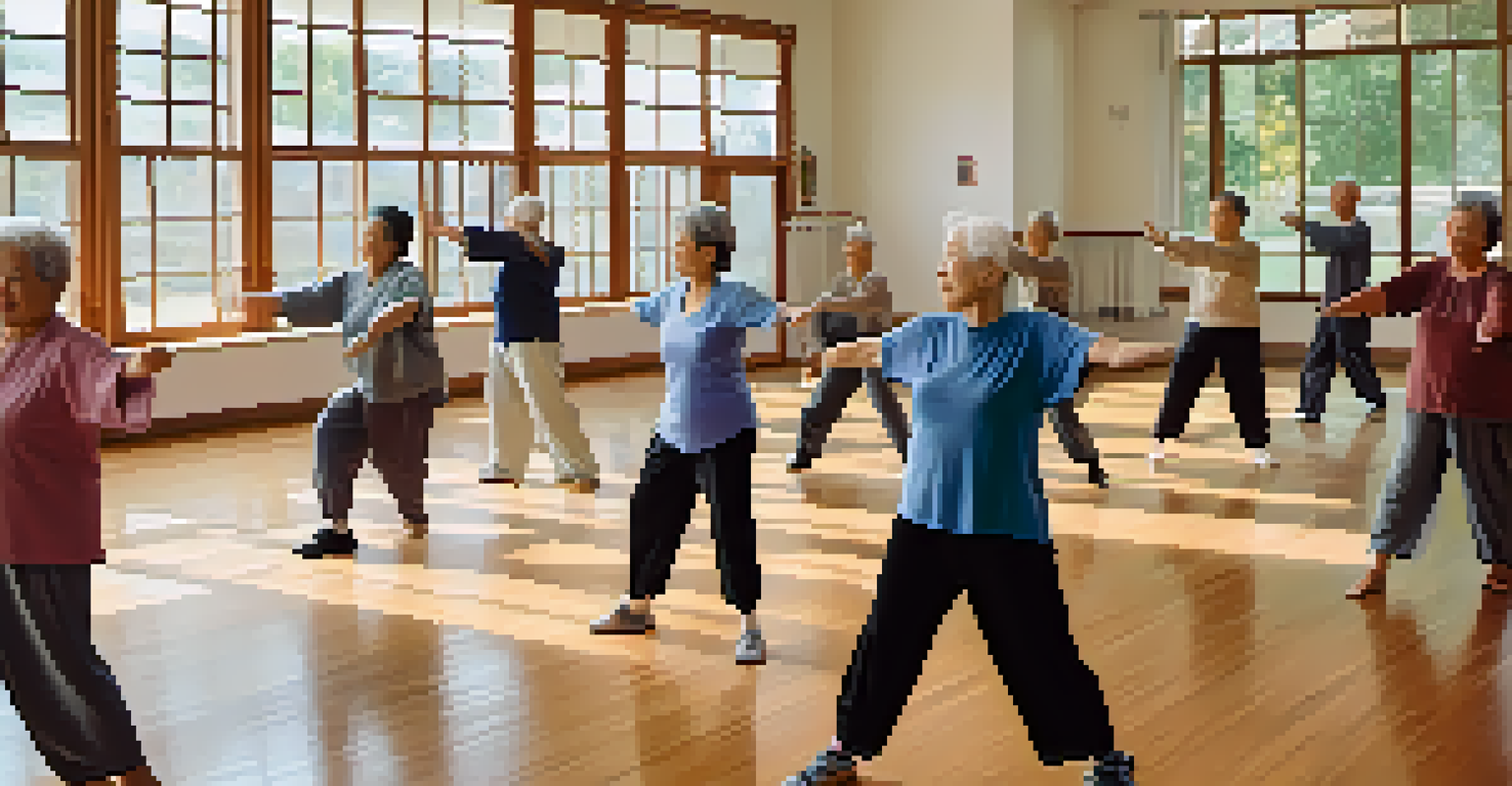How Tai Chi Balances Mind and Body for Well-Being

Introduction to Tai Chi and Its Benefits
Tai Chi is often described as 'meditation in motion,' a practice that combines slow, graceful movements with deep breathing. This ancient Chinese martial art has gained popularity worldwide, especially for its health benefits. Many practitioners find that it not only strengthens their bodies but also calms their minds, making it a holistic approach to well-being.
Tai Chi is a form of exercise that emphasizes the connection between mind and body, leading to a sense of well-being.
The beauty of Tai Chi lies in its accessibility; people of all ages and fitness levels can participate. As you flow through the movements, you're not just exercising your body; you're also engaging your mind. This dual focus fosters a sense of peace and balance that can be hard to find in our hectic lives.
In a world where stress often takes center stage, Tai Chi provides a gentle reminder of the importance of harmony. By cultivating both physical and mental health, it encourages a more balanced lifestyle, making it a treasured practice for many.
The Mind-Body Connection in Tai Chi
At its core, Tai Chi emphasizes the interconnectedness of the mind and body. Each movement is intentional and requires focus, which helps to anchor the mind in the present moment. This practice encourages practitioners to cultivate mindfulness, an essential component for mental clarity and emotional well-being.

As you move through the forms, you might find that your thoughts begin to settle, creating a tranquil state of awareness. This mental clarity can lead to improved decision-making and emotional resilience. Essentially, Tai Chi becomes a moving meditation that not only calms the mind but also aligns it with the body’s movements.
Holistic Benefits of Tai Chi
Tai Chi combines physical exercise with mental relaxation, promoting overall well-being.
By fostering this connection, Tai Chi enhances overall well-being. It serves as a reminder that taking care of our mental health is just as important as maintaining our physical health.
Physical Benefits of Practicing Tai Chi
Tai Chi is often praised for its physical benefits, which include improved flexibility, balance, and strength. The slow, controlled movements allow practitioners to build muscle without the strain often associated with traditional exercise. This makes it an excellent option for those recovering from injury or managing chronic health conditions.
The mind is everything. What you think you become.
Regular practice can lead to better posture and coordination, which enhances overall mobility. Additionally, Tai Chi has been shown to reduce the risk of falls in older adults, making it a vital practice for maintaining independence as we age. It’s a gentle yet effective way to enhance physical health over time.
Moreover, the rhythmic nature of Tai Chi promotes cardiovascular health. As you engage in this low-impact exercise, you’ll find that your heart and lungs benefit, leading to a more robust overall fitness level.
Mental Health Benefits of Tai Chi
Beyond physical health, Tai Chi serves as a powerful tool for mental health. The practice encourages relaxation and stress reduction, which can be particularly beneficial in today’s fast-paced society. Many practitioners report feeling calmer and more centered after sessions, which can significantly improve their quality of life.
Research has shown that regular Tai Chi practice can reduce symptoms of anxiety and depression. The meditative aspects of the movements help to quiet racing thoughts, allowing individuals to gain a clearer perspective on their emotions. This mental clarity can lead to a more positive outlook on life.
Mind-Body Connection Explained
The practice of Tai Chi enhances mindfulness, helping practitioners connect their thoughts and movements.
Incorporating Tai Chi into your routine can also foster a sense of community. Joining a Tai Chi class can provide social interactions that combat feelings of loneliness and isolation, further enhancing mental well-being.
The Role of Breath in Tai Chi Practice
Breath is a crucial element of Tai Chi, playing a significant role in balancing the mind and body. Practitioners focus on deep, diaphragmatic breathing, which not only supports physical movements but also calms the nervous system. This deep breathing helps to reduce stress and promote relaxation, creating a sense of inner peace.
As you synchronize your breath with movement, you cultivate a rhythm that enhances both the physical and mental experience of Tai Chi. This connection between breath and movement fosters a deeper awareness of your body, enabling you to listen to its needs.
Moreover, proper breathing techniques can improve lung capacity and overall respiratory health. By incorporating focused breathing into your daily routine, you can create a more mindful approach to both Tai Chi and life.
Tai Chi as a Mindfulness Practice
Mindfulness is about being present, and Tai Chi is a beautiful embodiment of this principle. Each movement requires focus and intention, allowing practitioners to immerse themselves fully in the experience. This practice encourages a break from the distractions of everyday life, making it a form of active meditation.
As you engage in Tai Chi, you learn to tune into your body and mind, observing how you feel without judgment. This heightened awareness can spill over into daily life, helping you to manage stress more effectively and maintain a sense of calm amidst chaos.
Accessible for Everyone
Tai Chi is suitable for all ages and fitness levels, making it an inclusive form of exercise.
Ultimately, the practice of Tai Chi teaches us the art of living in the moment. By embracing mindfulness through movement, we cultivate a greater appreciation for our lives and the world around us.
Getting Started with Tai Chi
If you're intrigued by the benefits of Tai Chi, starting your journey is easier than you might think. Many local community centers and gyms offer classes for beginners, making it accessible to everyone. Additionally, there are countless online resources and videos that can guide you through the basics of Tai Chi from the comfort of your home.
When beginning, it's important to approach the practice with an open mind and patience. Remember that mastery takes time, and the goal is not perfection but rather personal growth and well-being. Start with simple movements, gradually incorporating more complex forms as you become comfortable.

Most importantly, find a style and instructor that resonate with you. Tai Chi is a personal journey, and the right guidance can make all the difference in experiencing its full benefits.